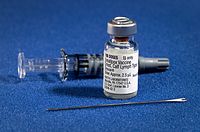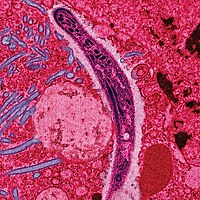
Investigation of Yersinia pestis and Yersinia pseudotuberculosis strains from Georgia and neighboring countries in the Caucasus by high-density SNP microarray
Sign Up to like & getrecommendations! Published in 2018 at "Archives of Microbiology"
DOI: 10.1007/s00203-018-1545-8
Abstract: Yersinia pestis, the causative agent of plague, is a recently evolved clone of the enteropathogenic bacterium Yersinia pseudotuberculosis. Y. pestis has been extensively studied for decades; however, there are insufficient data about the intra-species diversity… read more here.
Keywords: microarray; pestis; yersinia; yersinia pestis ... See more keywords

Oral vaccination against plague using Yersinia pseudotuberculosis.
Sign Up to like & getrecommendations! Published in 2017 at "Chemico-biological interactions"
DOI: 10.1016/j.cbi.2016.03.030
Abstract: Yersinia pestis, the agent of plague, is among the deadliest bacterial pathogens affecting humans, and is a potential biological weapon. Because antibiotic resistant strains of Yersinia pestis have been observed or could be engineered for… read more here.
Keywords: plague; pestis; vaccine; vaccination ... See more keywords

Plasmid-mediated doxycycline resistance in a Yersinia pestis strain isolated from a rat.
Sign Up to like & getrecommendations! Published in 2018 at "International journal of antimicrobial agents"
DOI: 10.1016/j.ijantimicag.2017.09.015
Abstract: The emergence of antibiotic-resistant Yersinia pestis strains represents a public health concern. Two antibiotic-resistant Y. pestis strains isolated from Madagascar have been previously identified and characterised. Both strains carried conjugative plasmids that conferred resistance to… read more here.
Keywords: pestis strain; pestis strains; pestis; resistance ... See more keywords

Single-dose intranasal subunit vaccine rapidly clears secondary sepsis in a high-dose pneumonic plague infection.
Sign Up to like & getrecommendations! Published in 2021 at "Vaccine"
DOI: 10.1016/j.vaccine.2021.01.040
Abstract: Yersinia pestis, the causative agent of plague, has killed millions throughout human history. Though public health initiatives have reduced the number of plague cases, it remains endemic in many areas of the world. It also… read more here.
Keywords: plague; pestis; tmv; histopathology ... See more keywords

Inhibition of the Yersinia pestis Methylerythritol Phosphate Pathway of Isoprenoid Biosynthesis by α-Phenyl-Substituted Reverse Fosmidomycin Analogues
Sign Up to like & getrecommendations! Published in 2020 at "ACS Omega"
DOI: 10.1021/acsomega.9b04171
Abstract: Fosmidomycin inhibits IspC (1-deoxy-d-xylulose 5-phosphate reductoisomerase), the first committed enzyme in the methylerythritol phosphate (MEP) pathway of isoprenoid biosynthesis. The MEP pathway of isoprenoid biosynthesis is essential to the causative agent of the plague, Yersinia… read more here.
Keywords: isoprenoid biosynthesis; pestis; pathway isoprenoid; phosphate ... See more keywords

Integrative approach using Yersinia pestis genomes to revisit the historical landscape of plague during the Medieval Period
Sign Up to like & getrecommendations! Published in 2018 at "Proceedings of the National Academy of Sciences of the United States of America"
DOI: 10.1073/pnas.1812865115
Abstract: Significance While our knowledge of modern plague reservoirs and their hosts is extensive, we have little to no knowledge about the origin of the Medieval plague pandemics or the routes of transmission involved in their… read more here.
Keywords: medieval period; plague; pestis; yersinia pestis ... See more keywords

Development of a double‐antibody sandwich ELISA for sensitive detection of Yersinia pestis
Sign Up to like & getrecommendations! Published in 2019 at "Microbiology and Immunology"
DOI: 10.1111/1348-0421.12751
Abstract: We developed a biotin–streptavidin‐based sandwich ELISA for the sensitive and specific detection of Yersinia pestis. In this assay, the F1 capsular protein and Y. pestis were captured by anti‐F1 mouse monoclonal antibody followed by detection… read more here.
Keywords: detection; elisa sensitive; pestis; antibody ... See more keywords

Plague, one lymph node at a time
Sign Up to like & getrecommendations! Published in 2018 at "Science"
DOI: 10.1126/science.362.6411.195-a
Abstract: Microbiology![Figure][1] The bacterium that causes plague, Yersinia pestis , in false color CREDIT: EYE OF SCIENCE/SCIENCE SOURCE Swollen lymph nodes, or buboes, are the hallmark of plague, which is caused by the pathogen Yersinia pestis… read more here.
Keywords: pestis; lymph; plague one; one lymph ... See more keywords

Gepotidacin is efficacious in a nonhuman primate model of pneumonic plague
Sign Up to like & getrecommendations! Published in 2022 at "Science Translational Medicine"
DOI: 10.1126/scitranslmed.abg1787
Abstract: Gepotidacin is a first-in-class triazaacenaphthylene antibacterial agent that selectively inhibits bacterial DNA gyrase and topoisomerase IV through a unique binding mode and has the potential to treat a number of bacterial diseases. Development of this… read more here.
Keywords: pestis; pneumonic plague; plague; model pneumonic ... See more keywords

A Widefield Light Microscopy-Based Approach Provides Further Insights into the Colonization of the Flea Proventriculus by Yersinia pestis
Sign Up to like & getrecommendations! Published in 2023 at "Applied and Environmental Microbiology"
DOI: 10.1128/aem.02091-22
Abstract: Yersinia pestis (the causative agent of plague) is one of the deadliest bacterial pathogens. It circulates primarily among rodent populations and their fleas. ABSTRACT Yersinia pestis (the agent of flea-borne plague) must obstruct the flea’s… read more here.
Keywords: flea; pestis; colonization; strain ... See more keywords

Induction of Type I Interferon through a Noncanonical Toll-Like Receptor 7 Pathway during Yersinia pestis Infection
Sign Up to like & getrecommendations! Published in 2017 at "Infection and Immunity"
DOI: 10.1128/iai.00570-17
Abstract: ABSTRACT Yersinia pestis causes bubonic, pneumonic, and septicemic plague, diseases that are rapidly lethal to most mammals, including humans. Plague develops as a consequence of bacterial neutralization of the host's innate immune response, which permits… read more here.
Keywords: type ifn; pestis; pestis infection; tlr7 ... See more keywords